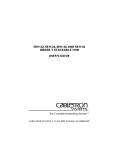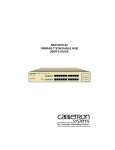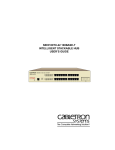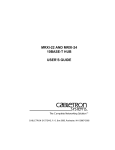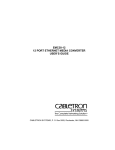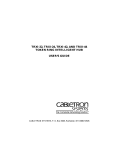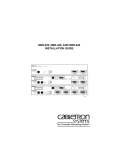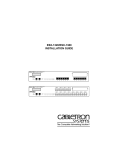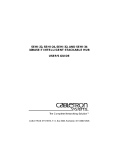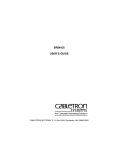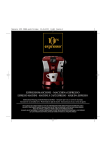Download Cabletron Systems EPIM F3 User`s guide
Transcript
SEH Book Page 1 Tuesday, March 19, 1996 4:12 PM SEH-22 AND SEH-24 10BASE-T STACKABLE HUB USER’S GUIDE CABLETRON SYSTEMS, P. O. Box 5005, Rochester, NH 03866-5005 SEH Book Page i Tuesday, March 19, 1996 4:12 PM NOTICE Cabletron Systems reserves the right to make changes in specifications and other information contained in this document without prior notice. The reader should in all cases consult Cabletron Systems to determine whether any such changes have been made. The hardware, firmware, or software described in this manual is subject to change without notice. IN NO EVENT SHALL CABLETRON SYSTEMS BE LIABLE FOR ANY INCIDENTAL, INDIRECT, SPECIAL, OR CONSEQUENTIAL DAMAGES WHATSOEVER (INCLUDING BUT NOT LIMITED TO LOST PROFITS) ARISING OUT OF OR RELATED TO THIS MANUAL OR THE INFORMATION CONTAINED IN IT, EVEN IF CABLETRON SYSTEMS HAS BEEN ADVISED OF, KNOWN, OR SHOULD HAVE KNOWN, THE POSSIBILITY OF SUCH DAMAGES. This electric hazard symbol appears in the SEH User’s Guide. Read all instructions following this symbol. Failure to follow the instructions appearing with this symbol could result in the presence of an electric hazard which has the potential to cause injury. © Copyright August 1995 by: Cabletron Systems, Inc. P.O. Box 5005, Rochester, NH 03866-5005 All Rights Reserved Printed in the United States of America Order Number: 9031491 August 1995 SPECTRUM, LANVIEW, and Remote LANVIEW are registered trademarks and EPIM-A, EPIM-C, EPIM-F1/F2/F3, EPIM-T, EPIM-X, HubSTACK, MicroMMAC, SEHI and SEH are trademarks of Cabletron Systems, Inc. CHAMP is a trademark of AMP, Inc. CompuServe is a registered trademark of CompuServe, Inc. DEC, VT200, VT300 and VT320 are trademarks of Digital Equipment Corporation. Ethernet is a trademark of Xerox Corporation. IBM is a registered trademark of International Business Machines Corporation. ST is a registered trademark of American Telephone and Telegraph Company UNIX is a trademark of Unix Systems Laboratories, Inc. Windows is a registered trademark of Microsoft Corporation. Printed On SEH USER’S GUIDE Recycled Paper i SEH Book Page ii Tuesday, March 19, 1996 4:12 PM NOTICE FCC NOTICE This device complies with Part 15 of the FCC rules. Operation is subject to the following two conditions: (1) this device may not cause harmful interference, and (2) this device must accept any interference received, including interference that may cause undesired operation. NOTE: This equipment has been tested and found to comply with the limits for a Class A digital device, pursuant to Part 15 of the FCC rules. These limits are designed to provide reasonable protection against harmful interference when the equipment is operated in a commercial environment. This equipment uses, generates, and can radiate radio frequency energy and if not installed in accordance with the operator’s manual, may cause harmful interference to radio communications. Operation of this equipment in a residential area is likely to cause interference in which case the user will be required to correct the interference at his own expense. WARNING: Changes or modifications made to this device which are not expressly approved by the party responsible for compliance could void the user’s authority to operate the equipment. DOC NOTICE This digital apparatus does not exceed the Class A limits for radio noise emissions from digital apparatus set out in the Radio Interference Regulations of the Canadian Department of Communications. Le présent appareil numérique n’émet pas de bruits radioélectriques dépassant les limites applicables aux appareils numériques de la class A prescrites dans le Règlement sur le brouillage radioélectrique édicté par le ministère des Communications du Canada. VCCI NOTICE This equipment is in the 1st Class Category (information equipment to be used in commercial and/or industrial areas) and conforms to the standards set by the Voluntary Control Council for Interference by Information Technology Equipment (VCCI) aimed at preventing radio interference in commercial and/or industrial areas. Consequently, when used in a residential area or in an adjacent area thereto, radio interference may be caused to radios and TV receivers, etc. Read the instructions for correct handling. ii SEH USER’S GUIDE SEH Book Page iii Tuesday, March 19, 1996 4:12 PM NOTICE CABLETRON SYSTEMS, INC. PROGRAM LICENSE AGREEMENT IMPORTANT: Before utilizing this product, carefully read this License Agreement. This document is an agreement between you, the end user, and Cabletron Systems, Inc. (“Cabletron”) that sets forth your rights and obligations with respect to the Cabletron software program (the “Program”) contained in this package. The Program may be contained in firmware, chips or other media. BY UTILIZING THE ENCLOSED PRODUCT, YOU ARE AGREEING TO BECOME BOUND BY THE TERMS OF THIS AGREEMENT, WHICH INCLUDES THE LICENSE AND THE LIMITATION OF WARRANTY AND DISCLAIMER OF LIABILITY. IF YOU DO NOT AGREE TO THE TERMS OF THIS AGREEMENT, PROMPTLY RETURN THE UNUSED PRODUCT TO THE PLACE OF PURCHASE FOR A FULL REFUND. CABLETRON SOFTWARE PROGRAM LICENSE 1. LICENSE. You have the right to use only the one (1) copy of the Program provided in this package subject to the terms and conditions of this License Agreement. You may not copy, reproduce or transmit any part of the Program except as permitted by the Copyright Act of the United States or as authorized in writing by Cabletron. 2. OTHER RESTRICTIONS. Program. 3. APPLICABLE LAW. This License Agreement shall be interpreted and governed under the laws and in the state and federal courts of New Hampshire. You accept the personal jurisdiction and venue of the New Hampshire courts. SEH USER’S GUIDE You may not reverse engineer, decompile, or disassemble the iii SEH Book Page iv Tuesday, March 19, 1996 4:12 PM NOTICE EXCLUSION OF WARRANTY AND DISCLAIMER OF LIABILITY 1. EXCLUSION OF WARRANTY. Except as may be specifically provided by Cabletron in writing, Cabletron makes no warranty, expressed or implied, concerning the Program (including Its documentation and media). CABLETRON DISCLAIMS ALL WARRANTIES, OTHER THAN THOSE SUPPLIED TO YOU BY CABLETRON IN WRITING, EITHER EXPRESS OR IMPLIED, INCLUDING BUT NOT LIMITED TO IMPLIED WARRANTIES OF MERCHANTABLITY AND FITNESS FOR A PARTICULAR PURPOSE, WITH RESPECT TO THE PROGRAM, THE ACCOMPANYING WRITTEN MATERIALS, AND ANY ACCOMPANYING HARDWARE. 2. NO LIABILITY FOR CONSEQUENTIAL DAMAGES. IN NO EVENT SHALL CABLETRON OR ITS SUPPLIERS BE LIABLE FOR ANY DAMAGES WHATSOEVER (INCLUDING, WITHOUT LIMITATION, DAMAGES FOR LOSS OF BUSINESS, PROFITS, BUSINESS INTERRUPTION, LOSS OF BUSINESS INFORMATION, SPECIAL, INCIDENTAL, CONSEQUENTIAL, OR RELIANCE DAMAGES, OR OTHER LOSS) ARISING OUT OF THE USE OR INABILITY TO USE THIS CABLETRON PRODUCT, EVEN IF CABLETRON HAS BEEN ADVISED OF THE POSSIBILITY OF SUCH DAMAGES. BECAUSE SOME STATES DO NOT ALLOW THE EXCLUSION OR LIMITATION OF LIABILITY FOR CONSEQUENTIAL OR INCIDENTAL DAMAGES, OR ON THE DURATION OR LIMITATION OF IMPLIED WARRANTEES IN SOME INSTANCES THE ABOVE LIMITATIONS AND EXCLUSIONS MAY NOT APPLY TO YOU. UNITED STATES GOVERNMENT RESTRICTED RIGHTS The enclosed product (a) was developed solely at private expense; (b) contains “restricted computer software” submitted with restricted rights in accordance with Section 52227-19 (a) through (d) of the Commercial Computer Software - Restricted Rights Clause and its successors, and (c) in all respects is proprietary data belonging to Cabletron and/or its suppliers. For Department of Defense units, the product is licensed with “Restricted Rights” as defined in the DoD Supplement to the Federal Acquisition Regulations, Section 52.227-7013 (c) (1) (ii) and its successors, and use, duplication, disclosure by the Government is subject to restrictions as set forth in subparagraph (c) (1) (ii) of the Rights in Technical Data and Computer Software clause at 252.2277013. Cabletron Systems, Inc., P.O. Box 5005, Rochester, New Hampshire 03866-5005. iv SEH USER’S GUIDE SEH Book Page v Tuesday, March 19, 1996 4:12 PM TABLE OF CONTENTS CHAPTER 1 1.1 1.2 1.3 1.4 1.5 1.6 1.7 USING THIS MANUAL ............................................................................ 1-1 GETTING HELP ...................................................................................... 1-2 SEH OVERVIEW ..................................................................................... 1-2 SEH FEATURES ..................................................................................... 1-3 STACKABLE CAPABILITIES .................................................................. 1-4 OPTIONAL FEATURES .......................................................................... 1-4 RELATED MANUALS.............................................................................. 1-6 CHAPTER 2 2.1 2.2 2.3 2.4 3.3 3.4 4.2 INSTALLATION UNPACKING THE SEH........................................................................... 3-1 INSTALLING THE SEH ........................................................................... 3-1 3.2.1 Tabletop or Shelf Installation..................................................... 3-2 3.2.2 Rackmount Installation Requirements....................................... 3-3 3.2.3 Attaching the Strain Relief Bracket............................................ 3-4 3.2.4 Rack Mounting the SEH ............................................................ 3-5 3.2.5 Stacking the SEH ...................................................................... 3-6 CONNECTING THE SEH TO THE POWER SOURCE........................... 3-9 ADDING/REPLACING EPIMs ................................................................. 3-9 CHAPTER 4 4.1 INSTALLATION REQUIREMENTS/SPECIFICATIONS CABLE SPECIFICATIONS ...................................................................... 2-1 2.1.1 HubSTACK Interconnect Cable Requirements ......................... 2-1 2.1.2 10BASE-T UTP and STP Cable Specifications......................... 2-2 NETWORK PORT SPECIFICATIONS .................................................... 2-4 TRANSCEIVER REQUIREMENTS ......................................................... 2-4 OPERATING SPECIFICATIONS............................................................. 2-5 CHAPTER 3 3.1 3.2 INTRODUCTION CONNECTING TO THE NETWORK CONNECTING THE SEH TO THE NETWORK ...................................... 4-1 4.1.1 Connecting Network Ports, SEH-22 and SEH-24 ..................... 4-1 4.1.2 Connecting a UTP Segment to an EPIM-T ............................... 4-3 4.1.3 Connecting a Fiber Segment to an EPIM-F1/F2/F3 .................. 4-4 4.1.4 Connecting a Thin-Net Segment to an EPIM-C ........................ 4-6 4.1.5 Connecting an AUI Cable to an EPIM-A ................................... 4-8 4.1.6 Connecting an AUI Cable to an EPIM-X ................................... 4-9 FINISHING THE INSTALLATION.......................................................... 4-10 SEH USER’S GUIDE v SEH Book Page vi Tuesday, March 19, 1996 4:12 PM CONTENTS CHAPTER 5 5.1 5.2 INSTALLATION CHECK-OUT .................................................................5-1 USING LANVIEW ....................................................................................5-2 APPENDIX A A.1 A.2 TROUBLESHOOTING EPIM INFORMATION EPIM SPECIFICATIONS ........................................................................ A-1 A.1.1 EPIM-T ..................................................................................... A-1 A.1.2 EPIM-F1 and EPIM-F2 ............................................................. A-2 A.1.3 EPIM-F3 ................................................................................... A-3 A.1.4 EPIM-C ..................................................................................... A-5 A.1.5 EPIM-A and EPIM-X (AUI Port)................................................ A-6 EPIM CABLE SPECIFICATIONS ........................................................... A-7 A.2.1 Multimode Fiber Optic Cable Specifications............................. A-7 A.2.2 Single Mode Fiber Optic Cable Specifications ......................... A-8 A.2.3 Thin-Net Network Requirements for the EPIM-C ..................... A-9 A.2.4 AUI Cable Requirements for the EPIM-A and EPIM-X........... A-10 INDEX vi SEH USER’S GUIDE SEH Book Page 1 Tuesday, March 19, 1996 4:12 PM CHAPTER 1 INTRODUCTION Welcome to the Cabletron Systems SEH-22 and SEH-24 10BASE-T Stackable Hubs User’s Guide. This manual provides installation instructions and reference information for the SEH-22 and SEH-24. 1.1 USING THIS MANUAL Read through this manual completely to familiarize yourself with its content and to gain an understanding of the features and capabilities of the SEH. A general working knowledge of Ethernet and IEEE 802.3 type data communications networks and their physical layer components is helpful when installing the SEH. Chapter 1, Introduction, outlines the contents of this manual, briefly describes SEH features, and concludes with a list of related manuals. Chapter 2, Installation Requirements/Specifications, describes installation requirements, network guidelines, and specifications. Chapter 3, Installation, contains instructions for installing the SEH as a stackable or stand-alone hub. Chapter 4, Connecting to the Network, explains how to connect the SEH to the network using the various media types. Chapter 5, Troubleshooting, describes how to use the LANVIEW LEDs to troubleshoot network problems. Appendix A, EPIM Information, provides specifications, cabling information, and switch settings for the Ethernet Port Interface Modules. SEH USER’S GUIDE 1-1 SEH Book Page 2 Tuesday, March 19, 1996 4:12 PM CHAPTER 1: INTRODUCTION 1.2 GETTING HELP If you need additional support related to the Cabletron Systems SEH, or if you have any questions, comments, or suggestions concerning this manual, contact Cabletron Systems Technical Support: By phone ..........................(603) 332-9400 Monday-Friday; 8am - 8pm Eastern Time By CompuServe ...............GO CTRON from any ! prompt By Internet mail [email protected] By FTP .............................134.141.197.25 Login: anonymous, Password: your email address 1.3 SEH OVERVIEW The SEH-22 is a non-intelligent repeating hub that has 12 RJ45 ports and one Ethernet Port Interface Module (EPIM) port on the front panel for network connections while the SEH-24 has 24 RJ45 ports and two EPIM ports on the front panel for network connections. Both models have two rear panel HubSTACK Interconnect Bus ports for stackable connections. EPIM-2 HubSTACK 10BASE-T HUB WITH LANVIEW® SEH-24 24 22 20 18 16 14 12 10 8 PWR MGMT CLN 6 4 2 RCV LNK RCV LNK 24X 22X 20X 18X 16X 14X 12X 10X 8X 6X 4X 2X 23X 21X 19X 17X 15X 13X 11X 9X 7X 5X 3X 1X E2 E1 23 21 19 17 15 13 11 9 7 5 3 1 EPIM-1 HubSTACK 10BASE-T HUB WITH LANVIEW® SEH-24 OUT SEH INTERCONNECT IN HubSTACK 10BASE-T HUB WITH LANVIEW® SEH-22 12 10 8 6 4 2 11 9 5 1 RCV LNK RCV LNK PWR MGMT CLN 12X 10X 8X 6X 4X 2X 11X 9X 7X 5X 3X 1X E1 7 3 EPIM-1 HubSTACK 10BASE-T HUB WITH LANVIEW® SEH-22 OUT SEH INTERCONNECT IN 1491_1 Figure 1-1. Front and Rear Views of the SEH-22 and SEH-24 1-2 SEH USER’S GUIDE SEH Book Page 3 Tuesday, March 19, 1996 4:12 PM SEH FEATURES Stack up to five SEH hubs using Cabletron Systems external HubSTACK Interconnect cables. Manage the stack by using the Cabletron Systems MicroMMAC or SEHI (Stackable Ethernet Hub with Intelligence). Up to four SEH hubs can be stacked with one intelligent hub. Stackable configurations make it possible to maintain only one IEEE repeater hop while providing up to 130 Ethernet ports. 1.4 SEH FEATURES Repeater Functionality The SEH fully conforms to the IEEE 802.3 Repeater, AUI, and 10BASE-T specifications, and provides the flexibility to connect networks using IEEE 802.3, Ethernet Version 1 or Version 2 equipment. The SEH transmits re-timed data packets, regenerates the preamble, extends fragments, and arbitrates collisions. The SEH automatically partitions problem segments, and reconnects repaired segments to the network. This feature minimizes the impact on network operation by isolating the problem segment. Only devices on the problem segment are affected. When the problem is solved, the SEH automatically reconnects the isolated segment to the network. Polarity Detection and Correction Each twisted pair port on the SEH incorporates a Polarity Detection and Correction feature that allows the SEH to pass data regardless of the polarity of the twisted pair segment’s receive link. Cabletron does not recommend operating in this condition. When this condition is discovered, remove the segment from the network and wire it correctly to reduce the potential for problems if equipment changes are made. LANVIEW LEDs Cabletron Systems LANVIEW Status Monitoring and Diagnostics System is a troubleshooting tool that helps in diagnosing power failures, collisions, cable faults, and link problems. The LANVIEW LEDs are located on the front panel. SEH USER’S GUIDE 1-3 SEH Book Page 4 Tuesday, March 19, 1996 4:12 PM CHAPTER 1: INTRODUCTION 1.5 STACKABLE CAPABILITIES The SEH is a non-intelligent hub designed to be managed by a Cabletron Systems intelligent hub such as the SEHI or the MicroMMAC. Intelligent hubs serve as the logical “top” of the stack. They manage all SEH hubs in the stack, providing full packet and error statistics for the entire stack, individual device, or individual port. Stack up to five SEH hubs for a non-managed stack or one intelligent hub and up to four SEH hubs for a managed stack. Hubs can be added or removed from the stack without powering down the entire stack. 1.6 OPTIONAL FEATURES The following features are not included with the SEH, but can be purchased separately from Cabletron Systems. Ethernet Port Interface Modules (EPIMs) EPIMs enable the expansion of a network through a variety of media. Cabletron offers the EPIMs shown in Table 1-1. Table 1-1. EPIMs EPIM Media Type Connector EPIM-A 10BASE-5 AUI DB15 (Female) EPIM-C 10BASE-2 Thin Coaxial BNC EPIM-T 10BASE-T Unshielded Twisted Pair RJ45 EPIM-X Standard Transceiver DB15 (Male) EPIM-F1 Multimode Fiber SMA EPIM-F2 Multimode Fiber ST EPIM-F3 Single Mode Fiber ST 1-4 SEH USER’S GUIDE SEH Book Page 5 Tuesday, March 19, 1996 4:12 PM OPTIONAL FEATURES Table 1-2 lists the board revision requirements for EPIMs used in the SEH-24. The board revision number is located on the EPIM’s printed circuit board directly after the part number as shown in Figure 1-2. Table 1-2. EPIM Board Revision Requirements EPIM EPIM BOARD REVISION EPIM-A Not Applicable EPIM-C 05 or greater EPIM-T 04 or greater EPIM-X 02 or greater EPIM-F1 05 or greater EPIM-F2 05 or greater EPIM-F3 02 or greater EPIM Board Revision CABLETRON SYSTEMS INC. PN 9000474 - 04 EPIM-T 1490_2 Figure 1-2. EPIM Board Revision Number SEH USER’S GUIDE 1-5 SEH Book Page 6 Tuesday, March 19, 1996 4:12 PM CHAPTER 1: INTRODUCTION HubSTACK Interconnect Cables Use Cabletron HubSTACK Interconnect cables to stack hubs together. Table 1-3 lists the part number and application for each cable. Table 1-3. HubSTACK Interconnect Cables P/N Description Application 9380110 12" HubSTACK Interconnect Cable SEH to SEH connections. 9380111 18" HubSTACK Interconnect Cable SEHI or MicroMMAC to SEH connections. Rack Mount Capabilities The SEH can be installed in a 19-inch rack. Cabletron offers an accessory package that includes the brackets, a strain relief for cable management and mounting screws. The part number for the accessory package is SEH-ACCY-KIT. See Chapter 3, Installation, for complete rack mounting instructions. 1.7 RELATED MANUALS Use the following Cabletron Systems manuals to supplement the procedures and other technical data provided in this manual. The procedures contained in these manuals are referenced where appropriate, rather than repeated in this manual. SEHI-22 and SEHI-24 10BASE-T Intelligent Hub User’s Guide MicroMMAC-22E/24E and MicroMMAC-32E/34E User’s Guide 1-6 SEH USER’S GUIDE SEH Book Page 1 Tuesday, March 19, 1996 4:12 PM CHAPTER 2 INSTALLATION REQUIREMENTS/SPECIFICATIONS This chapter describes network guidelines, power requirements, and operating specifications for the SEH. Be sure to read this chapter before you install the SEH. The network must meet the requirements and conditions specified in this chapter to obtain satisfactory performance from this equipment. Failure to follow these guidelines could result in poor network performance. 2.1 CABLE SPECIFICATIONS The SEH-22 and SEH-24 network ports support Shielded Twisted Pair (STP) and Unshielded Twisted Pair (UTP) cabling. Ethernet Port Interface Modules (EPIMs) expand a network using UTP, STP, Multimode Fiber Optic, Single Mode Fiber Optic, or Thin Coaxial cabling. For information concerning EPIMs, refer to Appendix A. The rear panel Interconnect Bus Ports support Cabletron Systems HubSTACK Interconnect cables for stackable applications. Take care in planning and preparing the cabling and connections for the network. The quality of the connections and the length of cables are critical factors in determining the reliability of your network. The following sections describe specifications for each media type. 2.1.1 HubSTACK Interconnect Cable Requirements Connect units in the stack with HubSTACK Interconnect cables. Refer to Chapter 1 for cable part numbers. The cables attach to the SEH rear panel bus ports. The rear panel of the SEH has an SEH Interconnect Bus Out Port (male connector) and an SEH Interconnect Bus In Port (female connector). The bus supports five stackable devices. SEH USER’S GUIDE 2-1 SEH Book Page 2 Tuesday, March 19, 1996 4:12 PM CHAPTER 2: INSTALLATION REQUIREMENTS/SPECIFICATIONS 2.1.2 10BASE-T UTP and STP Cable Specifications The devices and 10BASE-T Twisted Pair Segments connected to the SEH 10BASE-T Twisted Pair Network Ports and EPIM-T module must meet the IEEE 802.3 10BASE-T specifications shown below. Length The IEEE 802.3 10BASE-T standard requires that 10BASE-T devices transmit over a 100 meter (328 foot) link using 22-24 AWG unshielded twisted pair wire. However, cable quality largely determines maximum link length. With high quality, low attenuation cable, link lengths of up to 200 meters are achievable. Cable delay limits maximum link length to 200 meters, regardless of cable type. Insertion Loss The maximum insertion loss allowed for a 10BASE-T link is 11.5 dB at all frequencies between 5 and 10 MHz. This includes the attenuation of the cables, connectors, patch panels, and reflection losses due to impedance mismatches in the link segment. Impedance Cabletron Systems 10BASE-T Twisted Pair products work on twisted pair cable with 75 to 165 ohms impedance. Unshielded twisted pair cables typically have an impedance of between 85 to 110 ohms. Shielded twisted pair cables, such as IBM Type 1 cable, can also be used. The impedance of IBM Type 1 cable is typically 150 ohms. This increases the signal reflection caused by the cable, but because the cable is shielded, this signal reflection has little effect on the received signal’s quality due to the lack of crosstalk between the shielded cable pairs. Jitter Intersymbol interference and reflections cause jitter in the bit cell timing, resulting in data errors. A 10BASE-T link must not generate more than 5.0 ns of jitter. If the cable meets the impedance requirements for a 10BASE-T link, jitter should not be a concern. 2-2 SEH USER’S GUIDE SEH Book Page 3 Tuesday, March 19, 1996 4:12 PM CABLE SPECIFICATIONS Delay The maximum propagation delay of a 10BASE-T link segment must not exceed 1000 ns. This 1000 ns maximum delay limits the maximum link segment length to no greater than 200 meters. Crosstalk Crosstalk is caused by signal coupling between the different cable pairs contained within a multi-pair cable bundle. 10BASE-T transceivers are designed so that the user does not need to be concerned about cable crosstalk, provided the cable meets all other requirements. Noise Noise is caused by either crosstalk or externally induced impulses. Impulse noise may cause data errors if the impulses occur at very specific times during data transmission. Generally, the user need not be concerned about noise. If noise-related data errors are suspected, it may be necessary to either reroute the cable or eliminate the source of the impulse noise. Temperature Multi-pair PVC 24 AWG cables typically have an attenuation of 8 to 10 dB/100 meters at 20°C (68°F). The attenuation of PVC insulated cable varies significantly with temperature. At temperatures greater than 40°C (104°F), Cabletron recommends the use of plenum-rated cables to ensure that cable attenuation remains within specification. SEH USER’S GUIDE 2-3 SEH Book Page 4 Tuesday, March 19, 1996 4:12 PM CHAPTER 2: INSTALLATION REQUIREMENTS/SPECIFICATIONS 2.2 NETWORK PORT SPECIFICATIONS The SEH-22 and SEH-24 network ports use shielded RJ45 connectors that support both STP and UTP cabling. Figure 2-1 shows the RJ45 pinouts. 12345678 5X 1. Receive + 2. Receive 3. Transmit + 4. Not Used 1X 3X 5. Not Used 6. Transmit 7. Not Used 8. Not Used 1490_3 Figure 2-1. RJ45 Network Ports 2.3 TRANSCEIVER REQUIREMENTS When connecting an external network segment via a transceiver to the SEH with an EPIM-A, the following requirements must be met: 2-4 • The transceiver or Ethernet Device to which the module will be connected must meet IEEE 802.3 standards, and/or Ethernet Version 1.0 or Version 2.0 standards. • The Signal Quality Error (SQE) test function on the transceiver must be disabled when it is connected to a repeater or to an Ethernet Version 1.0 device. In addition, some Version 2.0 equipment does not support the SQE test. Devices that do not support the SQE test interpret the SQE test pulse as a collision. SEH USER’S GUIDE SEH Book Page 5 Tuesday, March 19, 1996 4:12 PM OPERATING SPECIFICATIONS 2.4 OPERATING SPECIFICATIONS This section describes the operating specifications for the SEH. Cabletron Systems reserves the right to change these specifications at any time without notice. General Delay Times (Start of Packets): Twisted Pair to EPIM- A 1.10 µs Twisted Pair to Twisted Pair 1.00 µs EPIM-A to Twisted Pair 1.00 µs Delay Times (JAM): Twisted Pair to EPIM-A 960 ns Preamble: Input: Minimum of 40 bits required Output: 64 bits min. (last 2 bits are 1, 1) JAM Output: Collisions are propagated through the network using the JAM signal of an alternating pattern of 1’s and 0’s in accordance with 802.3 specifications for a repeater unit. Fragment Extension: Packet fragments are extended to a minimum of 96 bits using the JAM [1, 0]. SEH USER’S GUIDE 2-5 SEH Book Page 6 Tuesday, March 19, 1996 4:12 PM CHAPTER 2: INSTALLATION REQUIREMENTS/SPECIFICATIONS Fault Protection: Each segment disconnects itself from the other segments if 32 consecutive collisions occur, or if the collision detector of a segment is on for longer than approximately 110 µs. This fault protection resets automatically after one packet is transmitted or received onto the fault protected segment without causing a collision. Power Requirements The SEH uses a universal power supply. The input power requirements are listed below. Table 2-1. Power Requirements Model Voltage Range Frequency Range SEH-22/SEH-24 100-125 VAC or 200-240 VAC 50-60 Hz The power supply has two outputs of +5 Vdc and +12 Vdc. The maximum output power is 20 W and the minimum efficiency is 65% under all conditions of line at full load. Environmental Requirements Operating Temperature: +5° to +50°C Non-operating Temperature: -30° to +90°C Operating Humidity: 2-6 (41° to 122°F) (-22° to 194°F) 5% to 95% (non-condensing) SEH USER’S GUIDE SEH Book Page 7 Tuesday, March 19, 1996 4:12 PM OPERATING SPECIFICATIONS Safety This unit meets the safety requirements of UL1950 (without D3 deviations), CSA C22.2 No. 950, and EN60950. EMI This unit meets the EMI requirements of FCC Part 15 Class A, EN55022 Class A and VCCI Class I. EMC This unit meets the EMC requirements of EN 50082-1 including: IEC 801-2 (ESD) levels 1 through 4, IEC 801-3 (Radiated Susceptibility) levels 1 through 4, and IEC 801-4 (EFT/B) levels 1 through 4. WARNING It is the responsibility of the person who sells the system to which the SEH will be a part to ensure that the total system meets allowed limits of conducted and radiated emissions. Physical Dimensions (H x W x D): 2.8" x 17.0" x 8.5" (7.2 cm x 43.6 cm x 21.6 cm) Weight: 4.9 lb Predicted MTBF: SEH-22/24: 847,921 hours SEH USER’S GUIDE (2.22 Kg) 2-7 SEH Book Page 1 Tuesday, March 19, 1996 4:12 PM CHAPTER 3 INSTALLATION This chapter outlines the procedure for attaching the SEH to a network as either a stackable or standalone device. Ensure that the network meets the guidelines and requirements outlined in Chapter 2, Installation Requirements/Specifications, before installing the SEH. Failure to follow installation instructions may result in an electrical shock hazard. 3.1 UNPACKING THE SEH Unpack the SEH as follows: 1. Remove the shipping material covering the SEH in the shipping box. 2. Carefully remove the SEH from the shipping box. 3. Remove the SEH from the protective plastic bag and set it aside to prevent damage. 4. Visually inspect the SEH. If there are any signs of damage, contact Cabletron Systems Technical Support immediately. 3.2 INSTALLING THE SEH The SEH may be installed on a tabletop or shelf, or in a 19-inch rack, and configured as a standalone or stacked hub. Refer to Section 3.2.1 for information concerning a tabletop or shelf installation. Section 3.2.2 describes the rackmount installation. SEH USER’S GUIDE 3-1 SEH Book Page 2 Tuesday, March 19, 1996 4:12 PM CHAPTER 3: INSTALLATION 3.2.1 Tabletop or Shelf Installation The following subsection provides guidelines for installation on a tabletop or shelf. Guidelines for Tabletop and Shelf Installation Tabletop and shelf installations must be within reach of the network cabling and meet the requirements listed below: • A single phase 120 Vac, 15 A, grounded power receptacle must be located within seven feet of the location. • In a shelf installation, the shelf must be able to support 30 pounds of static weight for each device in the stack. • The temperature for the selected location must be maintained between 5°C (41°F) and 50°C (122°F), and fluctuate less than 10°C per hour. For a free-standing shelf or tabletop installation, locate the SEH within seven feet of its power source and with an unrestricted free surface area 21 inches wide, 18 inches deep and 6 inches high, as shown in Figure 3-1. 21 IN. 18 IN. HubSTACK 10BASE-T HUB WITH LANVIEW® SEH-24 6 IN. 7 FT. 1491_02 Figure 3-1. Shelf or Tabletop Installation 3-2 SEH USER’S GUIDE SEH Book Page 3 Tuesday, March 19, 1996 4:12 PM INSTALLING THE SEH If the installation requires that the SEH be stacked, proceed to Section 3.2.5. Otherwise, continue by powering-up the SEH as described in Section 3.3. 3.2.2 Rackmount Installation Requirements To install the SEH in a 19-inch rack, Cabletron Systems offers an accessory kit that includes rack mount brackets, mounting screws, and a strain-relief bracket for cable management. The accessory kit is not included with the SEH, but is purchased separately from Cabletron Systems as part number SEH-ACCY-KIT. Rack mounting the SEH involves: • • • • Attaching the strain relief bracket Attaching the rackmount brackets Installing the SEH in a 19-inch rack Interconnecting SEH units when applicable Tools Required • Phillips Screwdriver Materials Required The following parts are included in the SEH-ACCY-KIT accessory kit. Use Figure 3-2 to determine the correct brackets to use for this application. • • • • Strain relief bracket Left and right rackmount brackets 8-32 x 1/4" panhead screws (4) 8-32 x 3/8" panhead screws (4) Use only the parts listed above to rack mount the SEH. The accessory kit includes other items not used in this application. Use of the wrong brackets or screws may result in damage to the unit or cause electrical shock. SEH USER’S GUIDE 3-3 SEH Book Page 4 Tuesday, March 19, 1996 4:12 PM CHAPTER 3: INSTALLATION Rack Mounting Brackets (2) Strain Relief Bracket 1491_08 Figure 3-2. SEH Rack Mounting Hardware 3.2.3 Attaching the Strain Relief Bracket Attach the strain relief bracket to the front of the SEH as follows: 1. Locate the strain relief bracket and four 8-32 x 3/8" screws from the accessory kit (see Figure 3-2). Do not use screws other than those included with the SEH accessory kit. Use of longer screws may damage the unit or cause electrical shock. 2. Attach the strain relief bracket to the bottom of the SEH (Figure 3-3). HubSTACK 10BASE-T HUB WITH LANVIEW® SEH-24 1491_03 Figure 3-3. Attaching the Strain Relief 3-4 SEH USER’S GUIDE SEH Book Page 5 Tuesday, March 19, 1996 4:12 PM INSTALLING THE SEH 3.2.4 Rack Mounting the SEH Refer to Figure 3-4 and perform these steps to install the SEH in a 19-inch rack. 1. Locate the four 8-32 x 1/4" screws and the two rackmount brackets in the accessory kit (see Figure 3-2). Do not use screws other than the four 8-32 x 1/4" screws included with the SEH accessory kit. Use of longer screws may damage the unit or cause electrical shock. 2. Using the four 8-32 x 1/4" screws provided in the accessory kit, attach the rack mounting brackets to the bottom of the SEH as shown in Figure 3-4. HubSTACK 10BASE-T HUB WITH LANVIEW® SEH-24 Rack Mounting Brackets (2) Screws (4) 1491_04 Figure 3-4. Installing the Rack Mount Brackets 3. With the mounting brackets installed, position the SEH between the vertical frame members of the 19-inch rack and fasten it securely with mounting screws as shown in Figure 3-5. SEH USER’S GUIDE 3-5 SEH Book Page 6 Tuesday, March 19, 1996 4:12 PM CHAPTER 3: INSTALLATION 19-Inch Rack HubSTACK 10BASE-T HUB WITH LANVIEW® SEH-24 Screws (4) 1491 05 Figure 3-5. Installing the SEH in the Rack If the installation requires that the SEH is to be stacked, proceed to Section 3.2.5. Otherwise, continue by connecting power as described in Section 3.3. 3.2.5 Stacking the SEH The rear panel of the SEH has an SEH Interconnect Bus In Port (female connector) and an SEH Interconnect Bus Out Port (male connector). Daisy chain units together using Cabletron Systems HubSTACK Interconnect cables. Table 3-1 describes each cable. Table 3-1. HubSTACK Interconnect Cables P/N Description Application 9380110 12" HubSTACK Interconnect Cable SEH to SEH connections. 9380111 18" HubSTACK Interconnect Cable SEHI or MicroMMAC to SEH connections. 3-6 SEH USER’S GUIDE SEH Book Page 7 Tuesday, March 19, 1996 4:12 PM INSTALLING THE SEH To stack SEHs, refer to Figure 3-6 and perform the following steps: 1. Attach one end of the SEH HubSTACK Interconnect cable to the bus port labeled “OUT” on the rear panel of the SEH. 2. Attach the other end of the SEH HubSTACK Interconnect cable to the bus port labeled “IN” on the rear panel of the SEH next in the stack. 3. Attach up to four SEH hubs in the stack repeating steps 1 and 2. HubSTACK 10BASE-T HUB WITH LANVIEW® SEH-24 HubSTACK 10BASE-T HUB WITH LANVIEW® SEH-24 OUT SEH INTERCONNECT OUT IN OUT SEH INTERCONNECT OUT IN SEH INTERCONNECT OUT IN SEH INTERCONNECT OUT IN HubSTACK 10BASE-T HUB WITH LANVIEW® SEH-24 OUT SEH INTERCONNECT SEH INTERCONNECT IN SEH INTERCONNECT IN HubSTACK 10BASE-T HUB WITH LANVIEW® SEH-24 HubSTACK 10BASE-T HUB WITH LANVIEW® SEH-24 OUT IN HubSTACK 10BASE-T HUB WITH LANVIEW® SEH-24 HubSTACK 10BASE-T HUB WITH LANVIEW® SEH-24 OUT SEH INTERCONNECT HubSTACK 10BASE-T HUB WITH LANVIEW® SEH-24 HubSTACK 10BASE-T HUB WITH LANVIEW® SEH-24 SEH INTERCONNECT IN HubSTACK 10BASE-T HUB WITH LANVIEW® SEHI-24 SEH INTERCONNECT OUT IN 1491_06 Figure 3-6. Stacking the SEH To attach an SEH to an SEHI, refer to Figure 3-6 and follow these steps: 1. Attach the SEHI HubSTACK Interconnect cable to the bus port labeled “OUT” on the rear panel of the SEHI. 2. Attach the other end of SEHI HubSTACK Interconnect cable to the bus port labeled “IN” on the rear panel of the SEH next in the stack. SEH USER’S GUIDE 3-7 SEH Book Page 8 Tuesday, March 19, 1996 4:12 PM CHAPTER 3: INSTALLATION If one end of a HubSTACK Interconnect cable is disconnected without disconnecting the other end attached to the hub, ensure that you disconnect the cable from the “OUT” port as shown in Figure 3-7. This ensures that the HubSTACK Interconnect cable is terminated properly. Disconnect SEH and SEHI Interconnect Cables at the "OUT" Port. HubSTACK 10BASE-T HUB WITH LANVIEW® SEH-24 OUT SEH INTERCONNECT IN HubSTACK 10BASE-T HUB WITH LANVIEW® SEH-24 OUT SEH INTERCONNECT IN HubSTACK 10BASE-T HUB WITH LANVIEW® SEHI-24 SEH INTERCONNECT OUT 1490_11 Figure 3-7. Disconnecting the HubSTACK Interconnect Cable Proceed to Section 3.3 to connect power. 3-8 SEH USER’S GUIDE SEH Book Page 9 Tuesday, March 19, 1996 4:12 PM CONNECTING THE SEH TO THE POWER SOURCE 3.3 CONNECTING THE SEH TO THE POWER SOURCE NOTE The SEH uses a universal power supply that operates between 100-125 VAC or 200-240 VAC at 50-60 Hz. Connect the SEH to the power source as follows: 1. Plug the power cord into the back panel of the SEH. 2. Plug the other end of the power cord into a grounded wall outlet. 3. Verify that the PWR LED is on; this indicates that the SEH is receiving power. 3.4 ADDING/REPLACING EPIMs This section contains procedures on how to add or replace an Ethernet Port Interface Module (EPIM) to upgrade or change the capabilities of your SEH. After installing a new EPIM, refer to the appropriate EPIM section in Appendix A to verify proper operation. ! Observe all static precautions while handling EPIMs. CAUTION To install an EPIM: NOTE When removing an EPIM, pull the module straight out to prevent damage to the connector. 1. Remove the coverplate or the EPIM (whichever applies). SEH USER’S GUIDE 3-9 SEH Book Page 10 Tuesday, March 19, 1996 4:12 PM CHAPTER 3: INSTALLATION 2. Slide the new EPIM into place, making sure that the connectors on the rear of the EPIM align correctly and firmly with the connector inside the SEH. Refer to Figure 3-8. 3. Install the mounting screw. EPIM-2 EPIM-1 LNK EPIM-T 1490_12 Figure 3-8. Installing an EPIM 3-10 SEH USER’S GUIDE SEH Book Page 1 Tuesday, March 19, 1996 4:12 PM CHAPTER 4 CONNECTING TO THE NETWORK This chapter outlines the procedure for connecting the SEH to a network. Ensure that the network meets the guidelines and requirements outlined in Chapter 2, Installation Requirements/Specifications, before installing the SEH. 4.1 CONNECTING THE SEH TO THE NETWORK The procedure for connecting network segments to the SEH varies depending on the media and ports being connected. Refer to the following list and perform the procedure described in the subsections that apply to your SEH: • • Network Ports SEH-22 and SEH-24 Connecting EPIMs to the Network 4.1.1 4.1.2 - 4.1.6 Prior to connecting the network cabling check the connectors for the proper pinouts as shown in Chapter 2. 4.1.1 Connecting Network Ports, SEH-22 and SEH-24 Attach unshielded twisted pair segments to the RJ45 Network Ports on the front panel of the SEH. Each twisted pair port on the SEH incorporates a Polarity Detection and Correction feature. The Polarity Detection and Correction feature allows the SEH to pass data regardless of the polarity of the twisted pair segment’s receive link. Operating in this condition is not recommended, the segment should be removed from the network and wired correctly by a technician. SEH USER’S GUIDE 4-1 SEH Book Page 2 Tuesday, March 19, 1996 4:12 PM CHAPTER 4: CONNECTING TO THE NETWORK Connect twisted pair segments to the SEH as follows: 1. Insert the RJ45 connector from each twisted pair segment into the desired network port on the SEH. See Figure 4-1. EPIM-2 LNK EPIM-T 12X 10X 8X 6X 4X 2X LNK EPIM-T 11X 9X 7X 5X 3X 1X EPIM-1 1490_13 Figure 4-1. SEH-24 Network Ports 2. Check that the applicable LNK LED for the port is on. If the LED is off, perform each of the following steps until it is on: a. Check that the 10BASE-T device at the other end of the twisted pair segment is powered up. b. Verify that the RJ45 connector on the twisted pair segment has the proper pinouts. Check the cable for continuity. c. Check that the twisted pair connection meets dB loss and cable specifications outlined Chapter 2. If a link is not established, contact Cabletron Systems Technical Support. 4-2 SEH USER’S GUIDE SEH Book Page 3 Tuesday, March 19, 1996 4:12 PM CONNECTING THE SEH TO THE NETWORK 4.1.2 Connecting a UTP Segment to an EPIM-T Before connecting a segment to the EPIM-T, check each end of the segment to determine if the wires are crossed over for the proper connection. If the wires do not cross over, use the switch on the EPIM-T to internally cross over the RJ45 port. Refer to Figure 4-2 to properly set the EPIM-T crossover switch. Position X (crossed over) 1. RX+ 2. RX3. TX+ 4. NC 5. NC 6. TX7. NC 8. NC Position = (not crossed over) 1. TX+ 2. TX3. RX+ 4. NC 5. NC 6. RX7. NC 8. NC 1490_14 Figure 4-2. EPIM-T Crossover Switch Connect an EPIM-T to a Twisted Pair Segment as follows: 1. Insert the RJ45 connector on the twisted pair segment into the RJ45 port on the EPIM. See Figure 4-2. 2. Check that the EPIM LNK LED is on. If the LED is off, perform each of the following steps until it is on: a. Check that the 10BASE-T device at the other end of the twisted pair segment is powered up. b. Verify the RJ45 connector’s pinouts. SEH USER’S GUIDE 4-3 SEH Book Page 4 Tuesday, March 19, 1996 4:12 PM CHAPTER 4: CONNECTING TO THE NETWORK c. Check the cable for continuity. d. Check that the twisted pair connection meets dB loss and cable specifications outlined in Chapter 2. e. Check that the crossover switch is in the correct position. If a link is not established, contact Cabletron Systems Technical Support. 4.1.3 Connecting a Fiber Segment to an EPIM-F1/F2/F3 When connecting a fiber optic link segment to an EPIM-F1, EPIM-F2, or EPIM-F3 keep the following in mind: 4-4 • When connecting a fiber optic link segment with SMA 906 connectors to an EPIM-F1 with SMA ports, ensure that half alignment sleeves are in place on each connector. A full alignment sleeve will damage the receive port. SMA 905 connectors do not need alignment sleeves. • To connect a segment with ST connectors to an EPIM-F2 /F3, keep in mind that ST connectors attach to ST ports much like BNC connectors attach to BNC ports. Insert the connector into the port with the alignment key on the connector inserted into the alignment slot on the port. Turn the connector to lock it down. • The physical communication link consists of two strands of fiber optic cabling: the Transmit (TX) and the Receive (RX). The Transmit strand from the applicable port on the module is connected to the Receive port of a fiber optic Ethernet device at the other end of the segment. The Receive strand of the applicable port on the module is connected to the Transmit port of the fiber optic Ethernet device. • Label the fiber optic cable to indicate which fiber is Receive and which is Transmit. Fiber optic cable purchased from Cabletron Systems is labeled so that one fiber is labeled 1 and the other fiber is labeled 2 at both ends of the cable. For cable not purchased from Cabletron Systems, label the cable as described above. SEH USER’S GUIDE SEH Book Page 5 Tuesday, March 19, 1996 4:12 PM CONNECTING THE SEH TO THE NETWORK Caution: Do not touch the ends of the fiber optic strands, and do not let the ends come in contact with dust, dirt, or other contaminants. Contamination of the ends causes problems in data transmissions. If the ends become contaminated, clean them with alcohol using a soft, clean, lint free cloth. Connect a segment to an EPIM-F1, EPIM-F2, or EPIM-F3 as follows: 1. Remove the plastic covers from the fiber optic ports on the applicable port on the module and from the ends of the connectors on each fiber strand. 2. Attach the fiber labeled 1 to the applicable receive port, labeled RX, on the module. See Figure 4-3. 3. Attach the fiber labeled 2 to the applicable port labeled TX, on the module. 4. At the other end of the fiber optic cable, attach the fiber labeled 1 to the transmit port of the device. 5. Attach the fiber labeled 2 to the receive port. 6. Check that the EPIM LNK LED is on. If the LED is off, perform the following steps until it is on: a. Check that the power is on for the device at the other end of the link. b. Verify proper “crossover” of fiber strands between the applicable port on the module and the fiber optic device at the other end of the fiber optic link segment. c. Verify that the fiber connection meets the dB loss specifications outlined in Chapter 2. If a link is not established, contact Cabletron Systems Technical Support. SEH USER’S GUIDE 4-5 SEH Book Page 6 Tuesday, March 19, 1996 4:12 PM CHAPTER 4: CONNECTING TO THE NETWORK F1/F2 ST Connectors F1/F2 SMA 906 Connectors w/ Half Alignment Sleeves SMA 905 Connectors F3 ST Connectors 1490_15 Figure 4-3. The EPIM-F1, EPIM-F2 and EPIM-F3 4.1.4 Connecting a Thin-Net Segment to an EPIM-C To connect a thin-net segment to an EPIM-C, refer to Figure 4-4 and perform the following steps: 1. Set the Internal Termination Switch labeled TERM to: • • The ON position ( ) if the thin-net segment connected directly to the port will be internally terminated at the port. • The OFF position (o) if the thin-net segment will not be terminated at the port or externally terminated. 2. If the Internal Termination switch is in the ON position, connect the thin-net segment directly to the BNC port as shown in Figure 4-4. 4-6 SEH USER’S GUIDE SEH Book Page 7 Tuesday, March 19, 1996 4:12 PM CONNECTING THE SEH TO THE NETWORK 3. If the Internal Termination switch is in the OFF position: a. Attach a BNC tee-connector to the BNC port on the module. b. Attach the thin-net segment to one of the female connectors on the tee-connector. NOTE Terminate each segment attached to the tee-connector. If a segment is not attached to one of the female connections on the tee-connector, place a terminator on that connection. c. Attach another thin-coax segment or a terminator to the other female connector on the tee-connector. When internal termination switch is set to off ( ): Connect BNC tee-connector to port. Attach a terminator or terminated thin-net segment to one female connector of tee-connector. Connect a terminated thin-net segment to other female connector of tee-connector. Attach thin-net segment directly to BNC connector when internal termination switch is set to on ( ). 1490_16 Figure 4-4. The EPIM-C SEH USER’S GUIDE 4-7 SEH Book Page 8 Tuesday, March 19, 1996 4:12 PM CHAPTER 4: CONNECTING TO THE NETWORK 4.1.5 Connecting an AUI Cable to an EPIM-A ! CAUTION Ensure that the Signal Quality Error (SQE or “heartbeat”) test function is disabled on the external transceiver connected to the SEH. The SEH will not operate and the network will be unusable if the transceiver has the SQE test function enabled. Refer to the applicable transceiver manual. Connect an EPIM-A to an external network segment as follows: 1. Attach an external transceiver to the network segment that will be connected to the AUI port. Refer to the applicable transceiver manual. 2. Attach an AUI cable, no longer than 50 meters in length, to the transceiver connected to the network in step 1. 3. Connect the AUI cable to the EPIM-A. (See Figure 4-5.) 4. Lock the AUI connector into place using the connector slide latch. EPIM-2 PWR EPIM-A 12X 10X 8X 6X 4X 2X PWR EPIM-A EPIM-1 11X 9X 7X 5X 3X 1X 1490_17 Figure 4-5. The EPIM-A 4-8 SEH USER’S GUIDE SEH Book Page 9 Tuesday, March 19, 1996 4:12 PM CONNECTING THE SEH TO THE NETWORK 5. Check that the PWR LED on the EPIM-A is on. If the LED is off, contact Cabletron Systems Technical Support. 6. If the PWR LED is on with the AUI cable disconnected, continue with the following checks: a. Check the AUI connections for proper pinouts. The pinouts for the transceiver connection are listed in Chapter 2. b. Check the cable for continuity. c. Reconnect the AUI cable to the SEH and the device. If the LED is still not on after reconnecting the segment, contact Cabletron Systems Technical Support. 4.1.6 Connecting an AUI Cable to an EPIM-X ! CAUTION The Signal Quality Error (SQE) switch remains in the OFF position for most network connections. However, some Data Terminal Equipment (DTE) requires SQE. Refer to your DTE manual for SQE requirement information. To connect an EPIM-X to a device not requiring SQE: 1. Check that the SQE LED on the EPIM-X is off. If the SQE LED is on, check the position of the SQE switch. NOTE If the SQE light remains on, even though the SQE switch is in the OFF position, contact Cabletron Technical Support. SEH USER’S GUIDE 4-9 SEH Book Page 10 Tuesday, March 19, 1996 4:12 PM CHAPTER 4: CONNECTING TO THE NETWORK 2. Attach one end of an AUI cable, no longer than 50 meters in length, to the port on the EPIM-X (Figure 4-6) and the other end to the intended node. ON Position (Toward Back of EPIM) ON OFF OFF Position (Toward Front of EPIM) 1490_18 Figure 4-6. The EPIM-X 4.2 FINISHING THE INSTALLATION The SEH is now ready for operation. Before placing the network into service, test the installation thoroughly, making sure that all stations can be addressed and that the SEH and all stations are indicating normal operation. Ensure that the networking software is configured properly to match the installed network. If errors or abnormal operation are encountered, proceed to Chapter 5, Troubleshooting. 4-10 SEH USER’S GUIDE SEH Book Page 1 Tuesday, March 19, 1996 4:12 PM CHAPTER 5 TROUBLESHOOTING This chapter contains instructions for using LANVIEW LEDs to troubleshoot physical layer network problems. 5.1 INSTALLATION CHECK-OUT After connecting the SEH to the network, verify that packets pass between all Ethernet devices connected to the SEH and any other devices connected to the network. If difficulty is encountered with any of the attached devices, check the link as follows: 1. Check that the LNK LED, if applicable, for the port is on. If the LED is off, try the following steps. a. Check that the 10BASE-T device at the other end of the twisted pair segment is powered up. b. Verify that the connector on the twisted pair segment has the proper pinouts. Refer to Chapter 2 for the pin assignments for twisted pair connectors. c. For EPIM-F1/EPIM-F2/EPIM-F3 check that the TX and RX fibers are properly connected. d. Check the cable for continuity. A variety of tools are available for this test, depending on the media you are using. e. Check that the twisted pair segments meet cable specifications for dB loss described in Chapter 2. SEH USER’S GUIDE 5-1 SEH Book Page 2 Tuesday, March 19, 1996 4:12 PM CHAPTER 5: TROUBLESHOOTING 2. If the remote station is ready and the LNK LED is on, but no data passes through the port, one of two conditions may exist: • Network management has disabled the port. • The port is segmented either because the collision detector was on for more than 110 µs or the SEH detected more than 32 consecutive collisions on the attached segment. The affected port remains segmented until a good packet is transmitted/received without collisions. If the LNK LED is still not on, contact Cabletron Systems Technical Support. 5.2 USING LANVIEW The SEH incorporates the Cabletron Systems LANVIEW Status Monitoring and Diagnostics System. LANVIEW LEDs help diagnose problems such as a power failure or a cable fault. The SEH includes the following LANVIEW LEDs: • PWR, for power status • MGMT, for management status • RCV (Receive), LNK (Link), and CLN (Collision) for Ethernet status. Figure 5-1 provides a quick reference chart of LED locations and definitions. This chapter also includes a detailed description of each LED. 5-2 SEH USER’S GUIDE SEH Book Page 3 Tuesday, March 19, 1996 4:12 PM USING LANVIEW HubSTACK SEH-24 10BASE-T HUB WITH LANVIEW® 24X 24 22 20 18 16 14 12 10 8 PWR MGMT CLN 6 4 2 RCV LNK RCV LNK E2 E1 23 21 19 17 15 13 11 9 7 5 3 1 23X LED Name LED Color Definition PWR (Power) Off No power Green (Solid) Power Green (Flashing) SEH managed by an intelligent hub Off SEH not managed CLN (Collision) Red Collision RCV (Receive) Yellow (Flashing) SEH is receiving data MGMT (Management) Off LNK (Link) No activity Green Link established Off No link 1491_07 Figure 5-1. LANVIEW LEDs PWR (Green) When this LED is on, the SEH is receiving power. If this LED is off, it indicates a loss of input power. Check the power source (circuit breaker, fuse, etc.). If the proper source power is present, the problem could be with the SEH. SEH USER’S GUIDE 5-3 SEH Book Page 4 Tuesday, March 19, 1996 4:12 PM CHAPTER 5: TROUBLESHOOTING MGMT (Green Flashing) This LED flashes when an intelligent hub manages the SEH. If this LED does not flash, an intelligent hub is not managing the SEH. If an intelligent hub is connected to the SEH and the LED does not flash, inspect the HubSTACK Interconnect cables for proper connections. CLN (Red) This LED indicates that a collision has occurred on one of the ports. RCV (Yellow Flashing) When this LED flashes, it indicates that the SEH is receiving data packets from the associated port segment. Each SEH port has a corresponding RCV LED: • Network Ports: RCV LEDs 1-24 • EPIM-1: RCV LED E1 • EPIM-2: RCV LED E2 LNK (Green) When a LNK LED is on, it indicates an established link between the associated port segment and the device at the other end of the segment. LNK LEDs remain on as long as a link is maintained. Each SEH Network Port (ports 1-22 on the SEH-22 and ports 1-24 on the SEH-24) has a corresponding LNK LED. 5-4 SEH USER’S GUIDE SEH Book Page 1 Tuesday, March 19, 1996 4:12 PM APPENDIX A EPIM INFORMATION A.1 EPIM SPECIFICATIONS EPIMs enable the connection of the SEH to the main network using different media types. Cabletron Systems offers a variety of EPIMs. The following sections explain specifications for each EPIM. A.1.1 EPIM-T The EPIM-T is an RJ45 connector supporting UTP cabling. It has an internal Cabletron Systems TPT-T 10BASE-T Twisted Pair Transceiver. The slide switch on the EPIM-T determines the cross-over status of the cable pairs. If the switch is on the X side, the pairs are internally crossed over. If the switch is on the = side, the pairs are not internally crossed over. Figure A-1 shows the pinouts for the EPIM-T in both positions. Position X (crossed over) 1. RX+ 2. RX3. TX+ 4. NC 5. NC 6. TX7. NC 8. NC Position = (not crossed over) 1. TX+ 2. TX3. RX+ 4. NC 5. NC 6. RX 7. NC 8. NC 1490_29 Figure A-1. EPIM-T Pinouts SEH USER’S GUIDE A-1 SEH Book Page 2 Tuesday, March 19, 1996 4:12 PM APPENDIX A: EPIM INFORMATION A.1.2 EPIM-F1 and EPIM-F2 The EPIM-F1 and EPIM-F2 shown in Figure A-2 support Multimode Fiber Optic cabling. Each EPIM has an internal Cabletron Systems FOT-F Fiber Optic Transceiver. The EPIM-F1 is equipped with SMA Connectors and the EPIM-F2 is equipped with ST Connectors. Specifications for the EPIMs are listed below. 1490_30 1490_31 Figure A-2. EPIM-F1 and EPIM-F2 Value Worst Case Worst Case Budget Typical Budget Receive Sensitivity -30.5 dBm -28.0 dBm — — Peak Input Power -7.6 dBm -8.2 dBm — — 50/125 µm fiber -13.0 dBm -15.0 dBm 13.0 dB 17.5 dB 62.5/125 µm fiber -10.0 dBm -12.0 dBm 16.0 dB 20.5 dB 100/140 µm fiber -7.0 dBm -9.0 dBm 19.0 dB 23.5 dB Parameter Typical Transmitter Power Error Rate -10 Better than 10 Note: The transmitter power levels and receive sensitivity levels listed are Peak Power Levels after optical overshoot. Use a Peak Power Meter compare the values given above to those measured on any particular port. If Power Levels are being measured with an Average Power Meter, add 3 dBm to the measurement to compare the measured values to the values listed (i.e., -33.5 dBm average + 3 dBm =-30.5 dBm peak). A-2 SEH USER’S GUIDE SEH Book Page 3 Tuesday, March 19, 1996 4:12 PM EPIM SPECIFICATIONS A.1.3 EPIM-F3 The EPIM-F3 shown in Figure A-3 supports Single Mode Fiber Optic cabling. It has an internal Cabletron Systems FOT-F Fiber Optic Transceiver and is equipped with ST Connectors. Specifications for the EPIM-F3 are listed on the following page. 1490_32 Figure A-3. EPIM-F3 Note: Transmitter Power decreases as temperatures rise and increases as temperatures fall. Use the Output Power Coefficient to calculate increased or decreased power output for your operating environment. For example, the typical power output at 25°C is -16.4 dBm. For a 4°C temperature increase, multiply the typical coefficient (-0.15 dBm) by four and add the result to typical output power (4 x -0.15 dBm + -16.4 = -17.0). SEH USER’S GUIDE A-3 SEH Book Page 4 Tuesday, March 19, 1996 4:12 PM APPENDIX A: EPIM INFORMATION Maximum Sensitivity (-36.0) Receive Sensitivity Typical Sensitivity (-31.0) Minimum Sensitivity (-30.0) Minimum Receive Input (-9.72) Typical Receive Input (-7.5) Maximum Receive Input Power Maximum Receive Input (-6.99) Maximum Transmit Power (-12.0) Transmitter Power* (At 25°C into 8.3/125µm fiber) Typical Transmit Power (-15.5) Minimum Transmit Power (-21.0) dBm -40 -35 -30 -25 -20 -15 -10 -5 Less Power * Transmit Power Typical Power Coefficient (See Note Below)-0.15dBm/ Parameter Transmitter Peak Wave Length 0 More Power Minimum Power °C Maximum Power -0.12 dBm/ °C-0.18 dBm/ °C Typical Minimum Maximum 1300 nm 1270 nm 1330 nm Spectral Width 60 nm Rise Time 3.0 ns 2.7 ns 5.0 ns Fall Time 2.5 ns 2.2 ns 5.0 ns Duty Cycle 50.1% 49.6% 50.7% Bit Error Rate: - 100 nm Better than 10-10 Note: The transmitter power levels given above are Peak Power Levels after optical overshoot. You must use a Peak Power Meter to correctly compare the values given above to those measured on any particular port. If you are measuring power levels with an Average Power Meter, add 3 dBm to the average power measurement to correctly compare the average power values measured to the values listed above (i.e., -33.5 dBm average + 3 dBm = -30.5 dBm peak). A-4 SEH USER’S GUIDE SEH Book Page 5 Tuesday, March 19, 1996 4:12 PM EPIM SPECIFICATIONS A.1.4 EPIM-C The EPIM-C supports thin-net coaxial cabling and is equipped with an internal Cabletron Systems TMS-3 Transceiver. Use the TERM switch on the front of the EPIM-C to set the internal 50 ohm terminator. This eliminates the need to connect the port to a tee-connector and terminator. Figure A-4 shows the settings for the terminator switch. TERM EPIM-C Internal Termination Switch = On (internally terminated) = Off (need external termination) 1490_34 Figure A-4. EPIM-C Connector Type BNC receptacle, with gold center contact, for use with BNC type teeconnectors and RG-58 thin-net cable. Grounding For safety, only one end of a thin-net segment should be connected to earth ground. Connection to earth ground at more than one point on the segment may cause dangerous ground currents. The BNC port of the Coaxial Interface Module is not internally connected to earth ground. SEH USER’S GUIDE A-5 SEH Book Page 6 Tuesday, March 19, 1996 4:12 PM APPENDIX A: EPIM INFORMATION A.1.5 EPIM-A and EPIM-X (AUI Port) The EPIM-A is a DB15 female connector used to attach segments to an external transceiver. The EPIM-X is equipped with dual internal transceivers. It has a DB15 male connector used to attach segments to an AUI cable. Figure A-5 shows both modules. 1490_35 Figure A-5. The EPIM-A and EPIM-X DB15 Pinouts Pin 1 2 3 4 5 6 7 8 Logic Ref. Collision + Transmit + Logic Ref. Receive + Power Return No Connection Logic Ref. Connector Shell: A-6 9 10 11 12 13 14 15 Collision Transmit Logic Ref. Receive Power (+12Vdc) Logic Ref. No Connection Protective Ground SEH USER’S GUIDE SEH Book Page 7 Tuesday, March 19, 1996 4:12 PM EPIM CABLE SPECIFICATIONS A.2 EPIM CABLE SPECIFICATIONS The following subsections provide cable specifications for the various EPIMs use in the SEH. A.2.1 Multimode Fiber Optic Cable Specifications Table A-1 shows Multimode Fiber Optic Cable specifications for the EPIM-F1 and EPIM-F2 modules. Table A-1. Multimode Fiber Optic Cable Specifications Cable Type Attenuation Maximum Cable Length 50/125 µm 13.0 dB or less 62.5/125 µm 16.0 dB or less 100/140 µm 19.0 dB or less The maximum allowable fiber optic cable length is 2 km (2187.2 yds). However, IEEE 802.3 specifications allow for a maximum of 1 km (1093.6 yds). Attenuation Test the fiber optic cable with a fiber optic attenuation test set adjusted for an 850 nm wavelength. This test verifies that the signal loss in a cable is within an acceptable level. Table A-1 shows the attenuation for each Multimode cable type. Fiber Optic Budget and Propagation Delay When determining the maximum fiber optic cable length, take into consideration the fiber optic budget delay and total network propagation before fiber optic cable runs are incorporated in any network design. Fiber optic budget is the combination of the optical loss due to the fiber optic cable, in-line splices, and fiber optic connectors. Propagation delay is the amount of time it takes data to travel from the sending device to the receiving device. Total propagation delay allowed for the entire network must not exceed 25.6 µs in one direction (51.2 µs round trip). If the total propagation delay between any two nodes on the network exceeds 25.6 µs, use bridges. SEH USER’S GUIDE A-7 SEH Book Page 8 Tuesday, March 19, 1996 4:12 PM APPENDIX A: EPIM INFORMATION A.2.2 Single Mode Fiber Optic Cable Specifications Table A-2 shows Single Mode Fiber Optic Cable specifications for the EPIM-F3. Table A-2. Single Mode Fiber Optic Cable Specifications Cable Type Attenuation Maximum Cable Length 8/125-12/125 µm 10.0 dB or less The maximum allowable fiber optic cable length is 5 km (3.1 miles) with bridges at each segment end. However, IEEE 802.3 FOIRL specifications specify a maximum of 1 km (1093.6 yds). Attenuation Test the fiber optic cable with a fiber optic attenuation test set adjusted for an 1300 nm wavelength. This test verifies that the signal loss in a cable is 10.0 dB or less for any given single mode fiber optic link. Fiber Optic Budget and Propagation Delay Fiber optic budget is the combination of the optical loss due to the fiber optic cable, in-line splices, and fiber optic connectors. When determining the maximum fiber optic cable length, the fiber optic budget (total loss of 10.0 dB or less between stations) and total network propagation delay must be considered before fiber optic cable runs are incorporated in any network design. Propagation delay is the amount of time it takes data to travel from the sending device to the receiving device. Total propagation delay allowed for the entire network must not exceed 25.6 µs in one direction (51.2 µs round trip). If the total propagation delay between any two nodes on the network exceeds 25.6 µs, use bridges. A-8 SEH USER’S GUIDE SEH Book Page 9 Tuesday, March 19, 1996 4:12 PM EPIM CABLE SPECIFICATIONS A.2.3 Thin-Net Network Requirements for the EPIM-C When you connect a thin-net segment to the SEH (via an EPIM-C), your network must meet the following requirements: Cable Type Use 50 ohm RG-58A/U coaxial cable to make up a thin-net segment. Length The thin-net segment must be no longer than 185 meters. Terminators Connect a 50 ohm terminator to the far end of each thin-net segment. Connectors A maximum of 29 tee-connectors may be used throughout the length of cable segment for host connections. If an excessive number of barrel connectors are used within the cable segment, such as finished wall plates with BNC feed-throughs, a reduced number of host connections may be required. For special network design, contact Cabletron Systems Technical Support. Grounding For safety, ground only one end of a thin-net segment. Do NOT connect EPIM BNC ports to earth ground. For safety, only one end of a thin-net segment should be connected to earth ground. Connection to earth ground at more than one point on the segment may cause dangerous ground currents. SEH USER’S GUIDE A-9 SEH Book Page 10 Tuesday, March 19, 1996 4:12 PM APPENDIX A: EPIM INFORMATION A.2.4 AUI Cable Requirements for the EPIM-A and EPIM-X To connect an external network segment to the SEH (via an EPIM-A or EPIM-X), the AUI cable must meet the following requirements: AUI Cable The cable between the module and device must be IEEE 802.3 type cable. Length The AUI Cable must not exceed 50 meters in length. If 28 AWG thin office drop cable is used, the maximum length is 15.24 meters (50 feet). Grounding The connector shells of the EPIM-A and EPIM-X connect to ground. A-10 SEH USER’S GUIDE SEH Book Page 1 Tuesday, March 19, 1996 4:12 PM INDEX C R Cable Specifications 2-1 UTP and STP 2-2 Connecting to the Network 4-1 Rack Mounting 3-5 accessory kit 1-6 S D Daughter Board 1-6 Daughter Board Upgrade Kit 1-6 E EMC Requirements 2-7 EMI Requirements 2-7 EPIM Installation 3-9 EPIM-A A-6 EPIM-C A-5 EPIM-F1 A-2 EPIM-F2 A-2 EPIM-F3 A-3 EPIMs 1-4 EPIM-T A-1 EPIM-X A-6 Safety Requirements 2-7 Slide switch A-1 SQE 2-4 Stacking the SEH 3-6 Strain Relief Bracket 3-4 T Technical Support 1-2 TERM switch A-5 Troubleshooting 5-1 U USING LANVIEW 5-2 H HubSTACK Interconnect Cables 1-6 I Installing the SEH 3-1 L LANVIEW LEDs 5-3 N Network Port Specifications 2-4 P Polarity Detection and Correction 1-3 SEH USER’S GUIDE Index-1 SEH Book Page 3 Tuesday, March 19, 1996 4:12 PM POWER SUPPLY CORD The mains cord used with this equipment must be a 2 conductor plus ground type with minimum 0.75 mm square conductors and must incorporate a standard IEC appliance coupler on one end and a mains plug on the other end which is suitable for the use and application of the product and that is approved for use in the country of application. GERMAN: Die Netzleitung, die mit diesem Geraet benuetzt wird, soll einen zwei Leiter mit Erdleiter haben, wobei die Leiter mindestens 0.75 mm sind, mit einer normalen IEC Geraetesteckdose an einem Ende und einem Geraetestecker am anderen Ende versehen sind, der fuer den Gebrauch und die Anwendung des Geraetes geeignet und der zum Benuetzen im Lande der Anwendung anerkannt ist. SPANISH: El cable principal de la red eléctrica utilizado con este equipo debe tener 2 conductores y 1 toma de tierra con un mínimo de 0.75 mm2 cada uno y necesita tener un aparato de acoplamiento standard IEC en un extremo y un enchufe para el cable principal de la red eléctrica en el otro extremo, lo cual sea adecuado para el uso y applicación del producto y lo cual sea aprobado para uso en el pais de applicación. FRENCH: Le cordon d' alimentation reliant cet appareil au secteur doit obligatoirement avoir deux fils conducteurs de 0.75 mm2 minimum et un fil de terre. It doit également être équipé du côté appareil d'une fiche agrée IEC et du côte secteur, d'une prise adaptée à l'usage du produit et aux normes du pays où l'appareil est utilisé.

























































